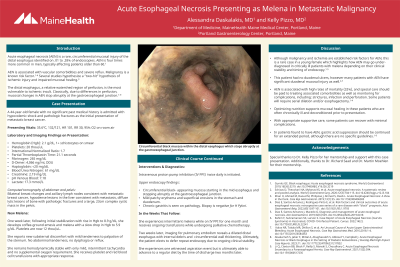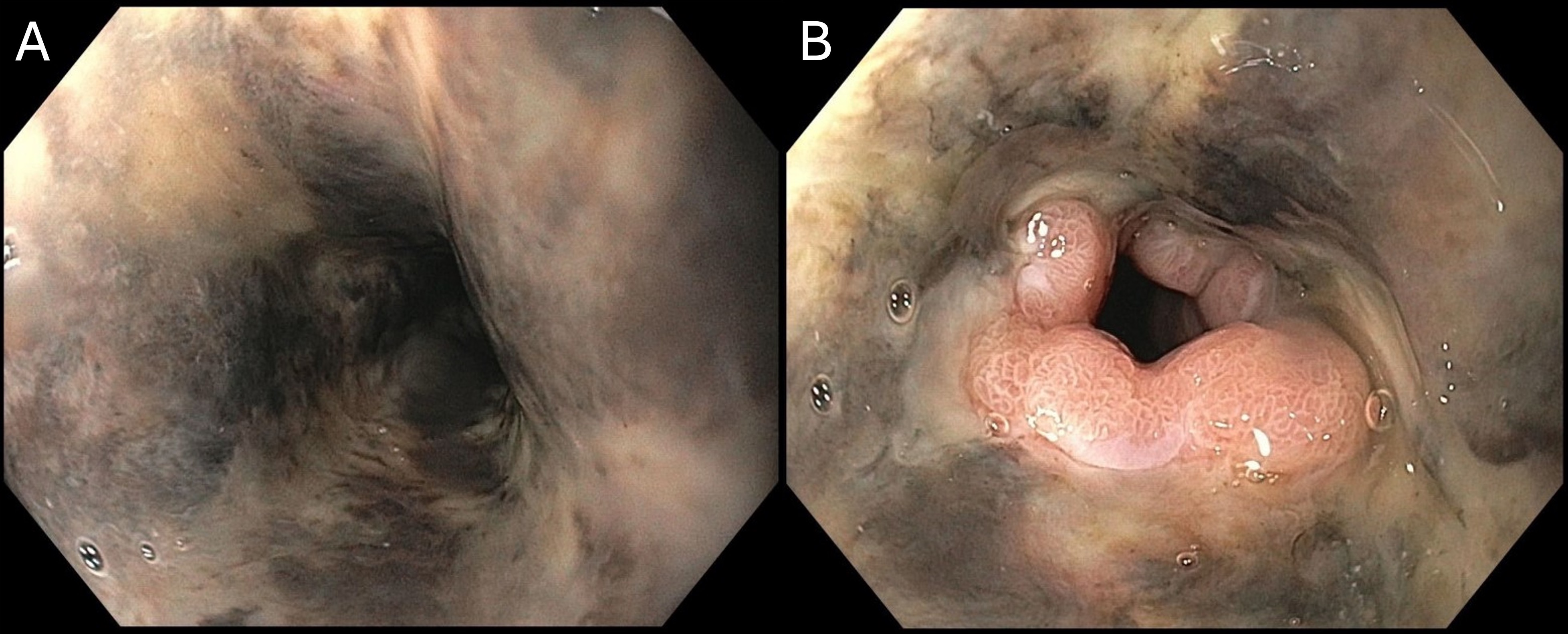Monday Poster Session
Category: Esophagus
P2287 - Acute Esophageal Necrosis Presenting as Melena in Metastatic Malignancy
Monday, October 28, 2024
10:30 AM - 4:00 PM ET
Location: Exhibit Hall E

Has Audio

Alessandra Daskalakis, MD
Maine Medical Center
Portland, ME
Presenting Author(s)
Alessandra Daskalakis, MD1, Kelly Pizzo, MD2
1Maine Medical Center, Portland, ME; 2Portland Gastroenterology Center, Portland, ME
Introduction: Acute esophageal necrosis (AEN) is a rare, circumferential mucosal injury of the distal esophagus identified on .01 to .28% of endoscopies (Gurvits, 2010). AEN is more common in men older than 60 with vascular comorbidities and reflux. Malignancy is a known risk factor.
Case Description/Methods: A previously healthy 44-year-old female presented with shock, profound anemia (hemoglobin 2.1), and pathologic fractures as the initial presentation of metastatic breast cancer. Early in her clinical course, she required multiple transfusions for persistently low blood counts despite adequate resuscitation. In the setting of thrombocytopenia, elevated INR and rare schistocytes, her coagulopathy was presumed multifactorial with both disseminated intravascular coagulation and bone marrow suppression contributing. A few days after admission she developed coffee ground emesis and melena with worsening anemia. Intravenous proton pump inhibition (IV PPI) was initiated. Endoscopy revealed circumferential black-appearing mucosa starting in the mid esophagus and stopping abruptly at the gastroesophageal junction suggestive of AEN. The stomach and duodenum were normal aside from mild patchy erythema and superficial erosions with chronic gastritis seen on pathology. Biopsy was negative for H Pylori. Cautious advancement of diet was well tolerated. She experienced intermittent melena while on a prolonged course IV PPI with occasional transfusions as needed. Two weeks later, imaging for pulmonary embolism revealed a dilated distal esophagus with internal debris and wall thickening. Ultimately, the patient elected to defer repeat endoscopy unless she began to develop clinical instability.
Discussion: Although malignancy is a known risk factor for AEN, this case illustrates AEN in a young woman. For comparison, AEN is four times more likely in men than in women (Gurvits, 2010). In patients with upper gastrointestinal bleed with ischemic insult and malignancy, AEN should be investigated as a contributing etiology. Sequalae of its healing may impact nutrition, safety and overall outcomes for these patients.
Gurvits GE. Black esophagus: acute esophageal necrosis syndrome. World J Gastroenterol. 2010 Jul 14;16(26):3219-25. doi: 10.3748/wjg.v16.i26.3219. PMID: 20614476; PMCID: PMC2900712

Disclosures:
Alessandra Daskalakis, MD1, Kelly Pizzo, MD2. P2287 - Acute Esophageal Necrosis Presenting as Melena in Metastatic Malignancy, ACG 2024 Annual Scientific Meeting Abstracts. Philadelphia, PA: American College of Gastroenterology.
1Maine Medical Center, Portland, ME; 2Portland Gastroenterology Center, Portland, ME
Introduction: Acute esophageal necrosis (AEN) is a rare, circumferential mucosal injury of the distal esophagus identified on .01 to .28% of endoscopies (Gurvits, 2010). AEN is more common in men older than 60 with vascular comorbidities and reflux. Malignancy is a known risk factor.
Case Description/Methods: A previously healthy 44-year-old female presented with shock, profound anemia (hemoglobin 2.1), and pathologic fractures as the initial presentation of metastatic breast cancer. Early in her clinical course, she required multiple transfusions for persistently low blood counts despite adequate resuscitation. In the setting of thrombocytopenia, elevated INR and rare schistocytes, her coagulopathy was presumed multifactorial with both disseminated intravascular coagulation and bone marrow suppression contributing. A few days after admission she developed coffee ground emesis and melena with worsening anemia. Intravenous proton pump inhibition (IV PPI) was initiated. Endoscopy revealed circumferential black-appearing mucosa starting in the mid esophagus and stopping abruptly at the gastroesophageal junction suggestive of AEN. The stomach and duodenum were normal aside from mild patchy erythema and superficial erosions with chronic gastritis seen on pathology. Biopsy was negative for H Pylori. Cautious advancement of diet was well tolerated. She experienced intermittent melena while on a prolonged course IV PPI with occasional transfusions as needed. Two weeks later, imaging for pulmonary embolism revealed a dilated distal esophagus with internal debris and wall thickening. Ultimately, the patient elected to defer repeat endoscopy unless she began to develop clinical instability.
Discussion: Although malignancy is a known risk factor for AEN, this case illustrates AEN in a young woman. For comparison, AEN is four times more likely in men than in women (Gurvits, 2010). In patients with upper gastrointestinal bleed with ischemic insult and malignancy, AEN should be investigated as a contributing etiology. Sequalae of its healing may impact nutrition, safety and overall outcomes for these patients.
Gurvits GE. Black esophagus: acute esophageal necrosis syndrome. World J Gastroenterol. 2010 Jul 14;16(26):3219-25. doi: 10.3748/wjg.v16.i26.3219. PMID: 20614476; PMCID: PMC2900712

Figure: Figure shows endoscopic images of circumferential black mucosa which begins at the mid esophagus (A) and stops abruptly at the gastroesophageal junction (B).
Disclosures:
Alessandra Daskalakis indicated no relevant financial relationships.
Kelly Pizzo indicated no relevant financial relationships.
Alessandra Daskalakis, MD1, Kelly Pizzo, MD2. P2287 - Acute Esophageal Necrosis Presenting as Melena in Metastatic Malignancy, ACG 2024 Annual Scientific Meeting Abstracts. Philadelphia, PA: American College of Gastroenterology.
